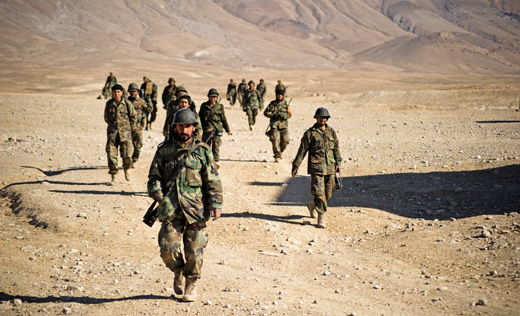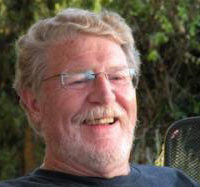
In spite of a White House declaration that “progress” is being made in Afghanistan, by virtually any measure the war has deteriorated significantly since the Obama administration surged troops into Kandahar and Helmand provinces. This past year has been the deadliest on record for U.S. and coalition troops. Civilian casualties are on the rise, and, according to the Red Cross, security has worsened throughout the country. U.S. allies are falling away, and the central government in Kabul has never been so isolated. Polls in Afghanistan, the U.S. and Europe reflect growing opposition to the nine-year conflict.
So why is the White House pursuing a strategy that is almost certain to accelerate a descent into chaos, and one that runs counter to the administration’s stated goal of a diplomatic solution to the war?
It is not an easy question to answer, in part because the major actors are hardly being straight with the public.
For instance, while U.S. commander Maj. Gen. David Petraeus says his strategy of counterinsurgency is making headway, in fact the military abandoned that approach long ago. Instead it has ramped up the air war and replaced the campaign to win “hearts and minds” with “night raids” aimed at assassinating or capturing Taliban leaders and supporters.
“Night raids” have more than tripled, from an average of 5 a night to 17, and they more and more resemble the Phoenix Program during the Vietnam War. Phoenix was aimed at decapitating the leadership of the National Liberation Front (NLF) and dismantling the NLF infrastructure in the countryside. It ended up assassinating somewhere between 40,000 and 60,000 people.
As in the Phoenix Program, night raids are directed at destroying “shadow governments” the Taliban have established in virtually every province in the country. Over the past three months, U.S. and NATO forces claim they have killed or captured 360 “insurgent leaders,” 960 “low-level leaders,” and some 2,400 fighters.
The Taliban have responded by assassinating government officials in Kandahar and increasing their cooperation with the two other insurgent groups, the Hizb-i-Islami and the Haqqani Group.
In spite of the raids, United Nations’ maps show that the central battlegrounds of Kandahar and Helmand provinces are still considered “very high risk” and the situation has grown considerably worse in the north and east.
The White House argues that the only solution to the long-running war is a diplomatic one, but the administration seems bent on systematically sabotaging that outcome by trying to kill the very people who will be central to any negotiated peace.
“By killing Taliban leaders, the war will not come to an end,” former Taliban Foreign Minister Wakil Ahmad Muttwakil told the Nations’ Jeremy Scahill, “on the contrary, things get worse.” Indeed, according to former Taliban leader Abdul Salam Zaeef, the killings push more radical leaders to the fore. “It will be worse for everyone if the [current] Taliban leadership disappears,” Zaeef told Scahill.
The U.S. has also sharpened its criticism of Pakistan to the point that a recent intelligence analysis essentially says that Islamabad is the major problem. There is even talk about sending U.S. Special Operations Forces (SOF) and the special 3,000-man Afghan army organized by the CIA into Pakistan to attack insurgent camps near the border, an act that would almost certainly further inflame anti-Americanism in that country.
In reality, there is not a whole lot Pakistan’s 600,000-man army can do. It is already fighting a homegrown Taliban, and its tense relations with India require it to keep substantial forces on their mutual border. It has also largely taken over the job of dealing with Pakistan’s devastating floods last year. But even were Pakistan to use all its forces, it is doubtful it could control the mountainous, 1553-mile border with Afghanistan.
The Pakistanis argue that current U.S. policy, not the border, is the problem. They point to the fact that the Americans have hitched themselves to the corruption-plagued Karzi government and have little to show for the billions of dollars spent to train the Afghan Army and police. “The Americans are looking for a scapegoat,” says leading Pakistan politician Mushahid Hussain.
Is the problem that Obama has turned the war over the military?
For all of Petraeus’ talk about “hearts and minds,” the military’s job description is to kill people. That is why Karl von Clausewitz, the great theoretician of modern war, pointed out that war is much too important a matter to be left in the hands of generals.
The Obama Administration seems paralyzed by a combination of those in its ranks who support a muscular foreign policy, like Secretary of State Hillary Clinton and the late Richard Holbrooke, a fear that the Republicans will brand them as “soft” in the 2012 elections, and an unwillingness to confront the generals.
The tragedy here is that many of the pieces for a deal are already in place. The Taliban and its allies are not tightly organized groups with a common ideology other than expelling invaders. They range from dedicated jihadists to local people fighting over turf or for revenge. And while Afghans have a reputation for being fierce, they actually excel at the art of the deal. If they did not, the country would have been depopulated long ago.
Of course, there are substantial roadblocks to overcome. The Taliban insists all foreign troops must leave, and the U.S. and Karzi demand the insurgents accept the Afghan constitution and put down their weapons. None of the above is likely to happen.
But the Taliban said back in 2008 that they would accept a “timetable” for foreign troops to leave. Of course both sides would have to agree to a ceasefire.
The U.S. will have to back off from its insistence that the insurgents accept the current constitution. The document establishes a powerful centralized government, a form of organization that flies in the face of the country’s history and which few Afghans outside of Kabul support. A constitution based on strong local autonomy would garner more support. In turn, the insurgents would have to guarantee that groups like al-Qaeda could not set up shop.
The Americans insist they will not talk with the Haqqani Group or others they consider “irreconcilables,” but you have to negotiate with the people you are fighting. No party has the right to veto the participation of another.
Any agreement will have to take into account regional security issues, including Islamabad’s fear that India will make Afghanistan a client state, thus surrounding Pakistan on both sides.
The polls are on the side of those who want to end the war.
A recent survey found that 83 percent of Afghanis want negotiations, (though 55 percent show little sympathy with the insurgency). According to an ABC/Washington Post poll, 60 percent of the American public say the war “is not worth fighting.” Opposition to the war is much higher in Europe, reaching 70 percent in Germany.
The U.S. polls suggest that any Republican charge of the administration being “soft” is not likely to make much headway with voters.
Further, the conflict is hemorrhaging money at a time of severe economic crisis. The war is costing $8 billion a month, not counting the tens of billions the U.S. has spent training the Afghan Army and police. So far, the cost of the Iraq and Afghan wars is $1.1 trillion, but, according to economists Joseph Stiglitz and Linda Bilmer, the long-term costs of both wars will be $3 trillion.
One thing Democrats in Congress can do is to press for a troop drawdown starting this year. Again, the polls show 55 percent support withdrawals starting in summer 2011, with another 27 percent saying it should begin sooner.
According to the Center for Strategic and Budgetary Assessments, delaying the withdrawal date from the end of 2011 – the President’s original goal – to 2014 will cost an extra $125 billion. As a comparison, the House Republicans pledge to cut $100 billion from the domestic budget – excluding the military, Homeland Security, and veterans – would require a 20 percent across-the-board cut in all programs.
The war is lost. We are broke. Many of the key protagonists are prepared to talk. It is time to silence the guns and seek common ground.
This article originally appeared in Conn Hallinan’s blog, “Dispatches from the Edge.”
Photo provided by NATO Training Mission: Afghan National Army recruits walk back to their formation after completing marksmanship training during Basic Warrior Training at the Kabul Military Training Center, Jan. 12, in Kabul, Afghanistan. U.S. Navy Petty Officer 2nd Class Ernesto Hernandez Fonte/AP










